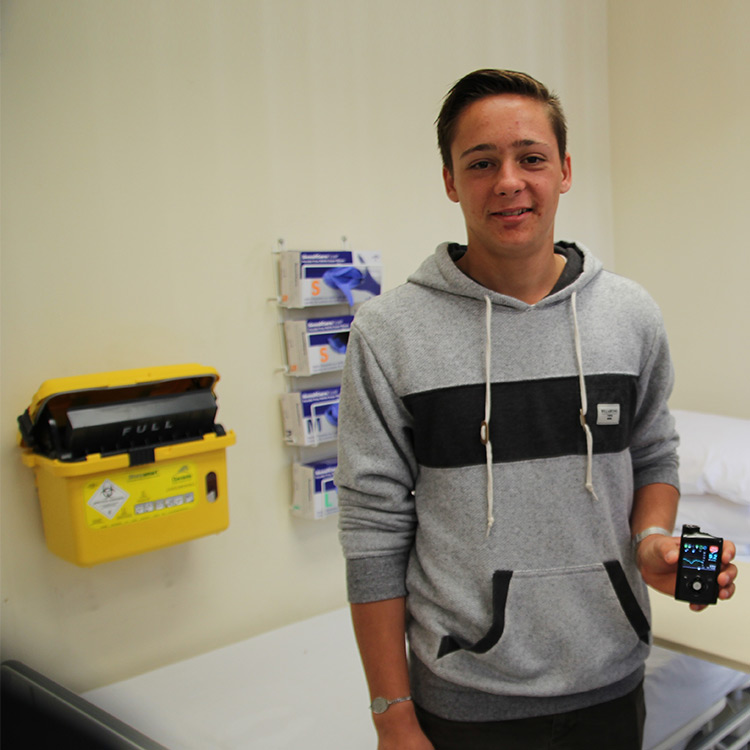Search
Research
Psychomotor Vigilance Testing on Neonatal Transport: A Western Australian ExperienceThis study aimed to assess whether undertaking retrieval was associated with fatigue independent of sleep and circadian disruption. It also aimed to assess the feasibility of routinely measuring the psychomotor vigilance test on neonatal transport. Fatigue is associated with impaired clinician performance and safety.
Research
Using co-design to understand and enhance the experiences of emerging adults with type 1 diabetes and their parents as they transition from paediatric to adult care in metropolitan and regional Western AustraliaKeely Bebbington MClinPsych/PhD McCusker Postdoctoral Research Fellow in Type 1 Diabetes 08 6319 1766 keely.bebbington@thekids.org.au McCusker
Research
Individual-Level Risk and Resilience Factors Associated with Mental Health in Siblings of Individuals with Neurodevelopmental Conditions: A Network AnalysisSiblings of individuals with neurodevelopmental conditions (NDCs) are exposed to unique family environments and experience a range of psychosocial risk and resilience factors.
Research
Implementation of a strategy to facilitate effective medical follow-up for Australian First Nations children hospitalised with lower respiratory tract infections: study protocolFirst Nations children hospitalised with acute lower respiratory infections (ALRIs) are at increased risk of future bronchiectasis (up to 15-19%) within 24-months post-hospitalisation. An identified predictive factor is persistent wet cough a month after hospitalisation and this is likely related to protracted bacterial bronchitis which can progress to bronchiectasis, if untreated.
Research
Looking beyond: complex holistic care needs of Syrian and Iraqi refugee children and adolescentsProtracted international conflict has seen escalating numbers of displaced and resettled Syrian and Iraqi refugees, raising concerns for their health and well-being. This paper describes the demographic and clinical profiles of recently resettled Syrian and Iraqi refugee children and adolescents across physical, psychosocial, developmental and educational domains using standardised multidisciplinary assessments.
Research
Associations Between Hyperphagia, Symptoms of Sleep Breathing Disorder, Behaviour Difficulties and Caregiver Well-Being in Prader-Willi Syndrome: A Preliminary StudyPrader-Willi syndrome (PWS) is a rare genetic disorder characterised by neurodevelopmental delays, hyperphagia, difficulties with social communication and challenging behaviours. Individuals require intensive supervision from caregivers which may negatively affect caregiver quality of life. This study used data collected in the Australasian PWS Registry to evaluate associations between child behaviours and caregiver mental well-being.
Research
A Small Device May Deliver King-Sized Solutions for Patients With an Exacerbation of Cystic FibrosisThe aim is to examine whether using a portable spring-infusor device to deliver antibiotics compared with a standard infusion pump (SIP) translated to (i) improve health outcomes, (ii) reduce the length of stay (LoS), and (iii) reduce cost for treatment of exacerbations of cystic fibrosis.
Research
Cohort profile: The WAACHS Linked Data StudyDespite the volume of accumulating knowledge from prospective Aboriginal cohort studies, longitudinal data describing developmental trajectories in health and well-being is limited.

News & Events
Local researchers lead biggest ‘artificial pancreas’ outpatient studyThe Children’s Diabetes Centre at The Kids Research Institute Australia is leading the longest and largest at-home trial of a hybrid closed-loop insulin pump system.
Research
Health service utilisation for acute respiratory infections in infants graduating from the neonatal intensive care unit: a population-based cohort studyDespite advances in neonatal intensive care, babies admitted to Neonatal Intensive Care Units (NICU) suffer from adverse outcomes. We aim to describe the longer-term respiratory infectious morbidity of infants discharged from NICU using state-wide population-based linked data in Western Australia.
Research
Do different glucose levels at calibration influence accuracy of continuous glucose monitoring readings in vitro?The purpose of this study was to determine whether the accuracy of CGMs also improves if multiple calibrations are performed in vitro.
Research
Relationship Between Social Motivation in Children With Autism Spectrum Disorder and Their ParentsImpairment in social motivation (SM) has been suggested as a key mechanism underlying social communication deficits observed in autism spectrum disorder (ASD). However, the factors accounting for variability in SM remain poorly described and understood. The current study aimed to characterize the relationship between parental and proband SM. Data from 2,759 children with ASD and their parents from the Simons Simplex Collection (SSC) project was included in this study.
Research
Reducing Rates of Severe Hypoglycemia in a Population-Based Cohort of Children and Adolescents With Type 1 Diabetes Over the Decade 2000–2009The objective of this study was to examine rates of severe hypoglycemia (SH) in a large population-based cohort of children with type 1 diabetes and...
Research
Evaluation of an Australian neurological nurse-led model of postdischarge careNeurological disorders are a leading cause of disease burden worldwide, placing a heavy demand on health systems. This study evaluated the impacts and cost savings of a community-based nursing service providing supported discharge for neurological patients deemed high-risk for unplanned emergency department presentations and/or hospital readmissions. It focused on adult patients with stroke, epilepsy, migraine/headache or functional neurological disorders discharged from a Western Australian tertiary hospital.
Research
Fatness, fitness, and increased cardiovascular risk in young childrenTo investigate the relationships between cardiorespiratory fitness and adiposity among young children, and their influence on a comprehensive cardiovascular ris
Research
Does commencement of a gluten- free diet improve blood glucose control in children and young people with Type 1 Diabetes and Coeliac Disease?If the gut becomes damaged it may not be able to process the foods that we eat as well as it used to. This may also affect how we look after diabetes.
Research
Aussi-AdDITInvestigating changes in retinopathy, aortic intima media thickness & heart rate variability, indicators of macrovascular disease & autonomic neuropathy

Research
Closed Loop Study – Day and Night Feasibility StudyA Closed-Loop System will potentially have a major impact upon acute and chronic complications of diabetes as well as upon their quality of life.
Research
Effect of blood glucose levels on the amount of glucose needed to maintain stable blood glucose levels during and after moderate intensity exercise in young people with type 1 diabetesDetermining if hyperglycaemia prior to and during exercise affects the amount of carbohydrate required to maintain stable glucose levels during/after exercise
Research
Epidemiology of hypoglycaemia in childhood-onset diabetes in Western AustraliaInvestigating the demographic, lifestyle and diabetes management factors associated with the incidence of severe hypoglycemia
